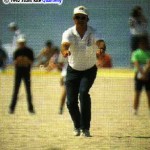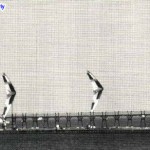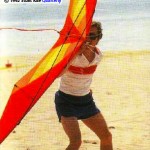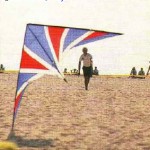All around the field at every competition and tournament you will see photographers. Every time a shutter is released the photographer hopes for that one great shot, perhaps one that will make an SKQ cover. Quite often, when the prints come back, the photographer is disappointed. Prints may be dark and underexposed, or those beautiful kites seem little more than dots. So what does it take to get those winning photos? Domination, location, timing, and a little technique.
Domination
Robert Capa – a photographer who made his living at the front during World War II – put it perfectly : “If your pictures aren’t good enough, you’re not close enough.” The main image, the main “idea” of your photograph, whether it is the kite. the flyer. or both. should dominate the frame. Can this be done at a competition? Yes, even with fixed-lens auto-focus cameras.
 The most obvious way to fill the frame is simply to move closer to the subject. However, this is not always possible. Competitors and judges alike might object to your climbing into the ring during an actual competition. But, you frequently can get quite close to the flyers while they are practicing. Many flyers are happy to be photographed then.
The most obvious way to fill the frame is simply to move closer to the subject. However, this is not always possible. Competitors and judges alike might object to your climbing into the ring during an actual competition. But, you frequently can get quite close to the flyers while they are practicing. Many flyers are happy to be photographed then.
If you decide to photograph during practice, there are several rules of courtesy. Remember, the flyers are working! They are preparing for a performance. It is your responsibility to not disturb that preparation. Likewise, you – the photographer – are responsible for the flyers’ safety. Don’t let them back over you. Tell the flyers you are there to take pictures. If they object, stop.
 Auto-everything cameras with fixed wide angle lenses in the 34mm to 45mm range are ideal for taking great pictures of the ground displays and the “ripstop jungles” that spring up at kite events. The trade-off for the convenience of these cameras is they may not be suitable for taking closeup pictures of kites in the air. If you can change lenses on your camera, a telephoto lens of 200mm or more can put you closer to the action on the field during the actual competition. I regularly use lenses up to 600mm to fill the frame with an individual flyer. Long lenses are also ideal for catching the color of the kites in the air. Using a monopod or tripod with a long lens will help ensure that your photo is in razor-sharp focus.
Auto-everything cameras with fixed wide angle lenses in the 34mm to 45mm range are ideal for taking great pictures of the ground displays and the “ripstop jungles” that spring up at kite events. The trade-off for the convenience of these cameras is they may not be suitable for taking closeup pictures of kites in the air. If you can change lenses on your camera, a telephoto lens of 200mm or more can put you closer to the action on the field during the actual competition. I regularly use lenses up to 600mm to fill the frame with an individual flyer. Long lenses are also ideal for catching the color of the kites in the air. Using a monopod or tripod with a long lens will help ensure that your photo is in razor-sharp focus.
When this isn’t possible, follow the general rule of thumb ; when handholding the camera. never shoot at a shutter speed slower than the focal length of the lens being used. If you are using a 200mm lens set your shutter speed no slower than 1/250 sec. The depth of field – how much of a scene is in focus in a photo – is limited when using telephoto lenses, unless you are willing to pay many thousands of dollars for a lens. You must decide which is most important for your picture. the flyer in the foreground or the kites in the background. It may be impossible to keep both in focus (small aperture) AND freeze the motion (fast shutter speed). You can compensate for this by using an ISO 200 or faster film
Location
 The best place to watch a sport kite routine is from behind the flyer. This is especially true of ballet. From behind the pilot you can watch the flow of the performance. If you shoot video, this is the place to be. Behind the pilot is also a great place for still photographers who want to emphasize the kites. But because the flyer’s back is usually toward you. this is not a particularly good place from which to shoot the flyer. Getting downwind of the action and aiming back gives you a better view of the pilot. If you want to concentrate on only the kites, a side view offers an interesting change of perspective.
The best place to watch a sport kite routine is from behind the flyer. This is especially true of ballet. From behind the pilot you can watch the flow of the performance. If you shoot video, this is the place to be. Behind the pilot is also a great place for still photographers who want to emphasize the kites. But because the flyer’s back is usually toward you. this is not a particularly good place from which to shoot the flyer. Getting downwind of the action and aiming back gives you a better view of the pilot. If you want to concentrate on only the kites, a side view offers an interesting change of perspective.
From a photographer’s vantage point a pilot who flies through a dog stake offers the best opportunity to capture the flyer and the kite in the frame together. Depth of field problems are solved because the kite and the flyer are on the same plane. You can use a slower, finer grain film and still keep everything sharp. Take the time to look around the field. Challenge yourself to find new angles. Observe the scene through your lens while laying on the ground. If there is an elevated announcer’s podium nearby ask the organizer for permission to use it and you will see things from a bird’s eye view.
Timing
Timing – the point at which you release the shutter – is closely related to ANTICIPATION. You must anticipate the position of the kites to know when to release the shutter.
Whether you’re trying to catch both the kite and the flyer together in one shot or trying to catch a team crossing in a thread, you must anticipate. The fact that you might be a sport kite flyer helps your anticipation and timing tremendously. Involvement in the sport helps you to know what to look for. The more you fly and the more flyers you watch. the better your timing will get.
Timing is also knowing when in a routine is the best time to shoot. For example, a classic and difficult shot is to get both the flyer and the kite in the same image, preferably with the kite in motion. This is most easily accomplished at launch or landing. Again, it is anticipation of the moment of launch that determines the timing of the shot.
Technique
 There are university degree programs devoted to photographic technique, and there certainly isn’t room here to teach the basics of photography. However, I previously referred to several basic photography concepts, including depth of field, shutter speed for stopping motion and film speed. I think one more is in order : exposure. Have you ever gotten prints taken at a kite festival only to find that they were so dark – underexposed – that you could hardly tell what the pictures were? Kites are relatively small, dark objects against the sky, which provides a very bright background.
There are university degree programs devoted to photographic technique, and there certainly isn’t room here to teach the basics of photography. However, I previously referred to several basic photography concepts, including depth of field, shutter speed for stopping motion and film speed. I think one more is in order : exposure. Have you ever gotten prints taken at a kite festival only to find that they were so dark – underexposed – that you could hardly tell what the pictures were? Kites are relatively small, dark objects against the sky, which provides a very bright background.
The light meter in your camera gets “fooled” into thinking that the scene is very light, and adjusts accordingly. You wind up with pictures that are too dark. All but the most simple cameras offer some adjustment for the “backlight” situation. Check your camera’s instruction manual. If your camera is adjustable or gives you a choice, select 1 to 1-1/2 stops of overexposure. This will compensate for a bright sky background.
In Closing
Try not to get frustrated. There will be some hits and some misses with nothing but clear sky. no kites at all. At first there will be a lot of near hits. This is not a science. Like kite flying itself. photographing kites is a process based on experience. Like kite flying, there will be good days and bad days. Simply put. the more often you take pictures, the better you will get.
John Cosby
Republished with permission from:
SKQ – Winter 1992, Volume 4 Issue 1
